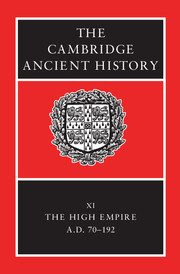Book contents
- Frontmatter
- PART I NARRATIVE
- PART II GOVERNMENT AND CIVIL ADMINISTRATION
- PART III THE EMPIRE
- PART IV ROME, ITALY AND THE PROVINCES
- PART Va ECONOMY AND SOCIETY
- 23 The land
- 24 Trade
- 25 Industry and technology
- 26 Commerce and finance
- 27 Demography
- 28 Status and patronage
- 29 Family and household
- PART Vb ART AND CULTURE
- Chronological Table
- BIBLIOGRAPHY
- Index
- 1 The Roman world in the time of Marcus Aurelius
- 7 The Danube provinces
- References
27 - Demography
from PART Va - ECONOMY AND SOCIETY
Published online by Cambridge University Press: 28 March 2008
- Frontmatter
- PART I NARRATIVE
- PART II GOVERNMENT AND CIVIL ADMINISTRATION
- PART III THE EMPIRE
- PART IV ROME, ITALY AND THE PROVINCES
- PART Va ECONOMY AND SOCIETY
- 23 The land
- 24 Trade
- 25 Industry and technology
- 26 Commerce and finance
- 27 Demography
- 28 Status and patronage
- 29 Family and household
- PART Vb ART AND CULTURE
- Chronological Table
- BIBLIOGRAPHY
- Index
- 1 The Roman world in the time of Marcus Aurelius
- 7 The Danube provinces
- References
Summary
The underlying demographic structure of the early Roman empire is only dimly perceptible. By and large we lack not only reliable statistical evidence for general demographic functions, but also the detailed local records that prove invaluable for early modern Europe. What we do have, in abundance, are impressionistic and often moralizing observations by literary sources; but such remarks, as vague and inconsistent as similar statements by modern lay persons, must always be considered suspect unless they can be verified. Anecdotes are of similarly marginal demographic interest. For these reasons we often have no choice but to fall back upon reasonable conjecture: likelihoods, not truths.
Further, the Roman empire spanned a vast geographic range, and it endured for centuries. To judge from early modern data, little uniformity can be anticipated of it – considerably less, indeed, than the discussion in this chapter may suggest.
Despite these handicaps, a picture is emerging. The Roman empire's demographic structure, to the extent we know it, broadly resembles most populations before the modern demographic transition; in particular, it is close to the norm for pre-modern Mediterranean societies, while displaying no divergences that clearly anticipate the demographic transition. It goes without saying that Rome's demographic structure fundamentally conditioned the economic, social and political institutions of the Roman empire.
Keywords
- Type
- Chapter
- Information
- The Cambridge Ancient History , pp. 787 - 816Publisher: Cambridge University PressPrint publication year: 2000
References
- 38
- Cited by

